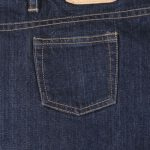Fraying is a common phenomenon with most types of trousers, including jeans. Jeans are made of denim. Over time, the individual cotton strands from which this denim is comprised may begin to unravel. When left unchecked, this can lead to fraying. The bottom of one or both pant legs may fray while becoming progressively worse.
Just because it’s a common phenomenon, though, doesn’t mean it’s unavoidable. No matter what color or style your jeans are, there are steps you can take to prevent them from fraying at the bottom. This post offers tips on how to prevent your jeans from fraying at the bottom.
Choose Heavyweight Jeans
The weight of your jeans will affect their susceptibility of fraying at the bottom. Generally speaking, heavier jeans are less likely to fray at the bottom than lighter jeans. All jeans are made of denim. But the amount of denim used in their construction may vary.
If you’re worried about fraying, choose a pair of heavyweight jeans consisting of more denim than lightweight jeans. Jeans made of 14 ounces of denim, for instance, are considered heavyweight. They are heavier than jeans made of just 10 or 12 ounces of denim. Therefore, they are less likely to fray at the bottom.
Consider Selvedge
You may want to consider selvedge denim jeans if you’re worried about them fraying at the bottom. Available for sale here at MakeYourOwnJeans, selvedge denim jeans are characterized by an old-style shuttle loom weaving process. They are made with the cross thread going back and forth. Other jeans, conversely, use a modern weaving process that doesn’t follow this same weaving pattern.
Not only are selvedge jeans strong; they are naturally protected against fraying at the bottom. If you inspect the bottom of selvedge jeans, you’ll notice they have a band of fabric that’s folded up a few inches and sewn into place. This band acts as a deterrent against fraying. The bottom of both pant legs features a band of folded denim fabric. As a result, there’s little or no risk of fraying. You wear a pair of selvedge jeans day after day for many years without them fraying at the bottom.
Wash on the Gentle Cycle
When washing your jeans, set your washing machine to the gentle cycle. Nearly all jeans are machine-washable. You don’t have to get your jeans dry-cleaned. As long as they are made of denim, it’s typically safe to wash them in the machine washing. Nonetheless, you should set your washing machine to the gentle cycle to protect them from fraying.
Most washing machines have multiple cycle settings. The gentle cycle lives up to its namesake by being slower and less aggressive than the other cycle settings. It will still clean your jeans; the gentle cycle will simply expose your jeans to less wear and tear, thereby protecting them from fraying and other forms of damage.

Roll Up the Bottom
While selvedge jeans are naturally protected from fraying thanks to the band of folded fabric at the bottom, other jeans lack this protection. Most jeans don’t have a band of folded fabric at the bottom. As a result, they are susceptible to fraying. A simple solution, though, is to roll up the bottom of your jeans.
You can prevent your jeans from fraying by rolling up the bottom. Just take the bottom of each pant leg and roll it up about 2 or 3 inches. Once rolled up, your jeans shouldn’t touch the ground, nor will they fray. You wear your jeans all day long with the bottom rolled up — and they shouldn’t fray. This is just one more way to prevent your jeans from fraying.
Choose the Right Style
It’s no secret that jeans are available in dozens of styles. With that said, the style doesn’t just affect the appearance of jeans; it affects the risk of fraying. Some styles of jeans are more susceptible to fraying than others.
Distressed, for instance, is a common style that’s highly susceptible to fraying. Distressed jeans are produced with signs of intentional wear and tear. They may feature fraying in the knees, thighs and bottom of the pant legs. The fraying is typically minimal. Nonetheless, it may become worse over time.
Non-distressed boot-cut jeans are a great choice if you’re worried about fraying. Boot-cut jeans are characterized by a wide opening around the bottom of the pant legs. With boot-cut jeans, you can fit the bottom of the pant legs over the top of your boots or other footwear so that they don’t drag on the ground. Regardless, you can protect your jeans from fraying by choosing the right style.
Line-Dry After Washing
After washing your jeans, you may want to line-dry them. Jeans can be machine-dried or line-dried. Machine-drying involves the use of a tumble clothes dryer, whereas line-drying involves hanging your jeans on a line — the line can be indoors or outdoors — to dry naturally in the air.
Your jeans are less likely to fray at the bottom if you line-dry them. Just take your jeans out of the washing machine and hang them on a line for about 20 minutes. When exposed to the air for this period of time, they’ll dry naturally. Machine-drying is a more aggressive drying technique that can make your jeans susceptible to fraying.
Get the Right Size
For maximum protection against fraying, your jeans need to fit. If they are too big or too small, they may fray at the bottom. Choosing jeans in the wrong size is a serious mistake. Not only will they look awkward when worn; they’ll degrade more quickly.
You can choose jeans in the right size by opting for custom sizing. Custom sizing involves the production of custom-fitted jeans based on your body measurements. You won’t be limited to choosing generic waist and length measurements. With custom-sized jeans, you can specify your precise body measurements, resulting in the perfect fit each and every time.











